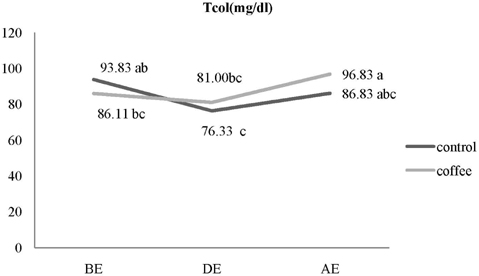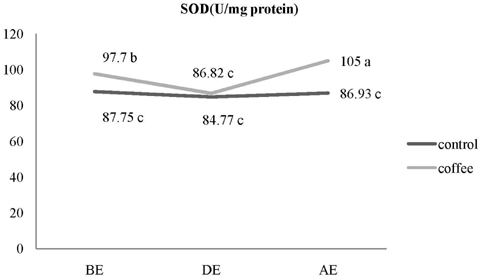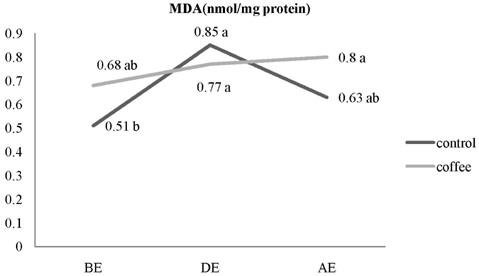Nutr Res Pract.
2010 Aug;4(4):283-289.
Coffee intake can promote activity of antioxidant enzymes with increasing MDA level and decreasing HDL-cholesterol in physically trained rats
- Affiliations
-
- 1Department of Food & Nutrition, Duksung Women's University, 419 Ssangmun-dong, Dobong-gu, Seoul 132-714, Korea. yunokcho@duksung.ac.kr
Abstract
- This study investigated the effect of coffee intake and exercise on the antioxidative activity and plasma cholesterol profile of physically trained rats while they were exercising. Forty eight rats were under either the control diet with water (C) or control diet with coffee (CF) and at the same time they were given physical training for 4 weeks. In terms of physical training, the rats were exercised on a treadmill for 30 minutes everyday. At the end of 4 weeks, animals in each dietary group were subdivided into 3 groups: before-exercise (BE); during-exercise (DE); after-exercise (AE). Animals in the DE group were exercised on a treadmill for one hour, immediately before being sacrificed. Animals in the AE group were allowed to take a rest for one hour after exercise. TG levels were significantly high in coffee intake group than in control group. Also TG level of AE group was significantly higher than that of BE group. Exercise and coffee-exercise interaction effects were significant in total cholesterol (P = 0.0004, 0.0170). The AE of coffee intake group showed highest total cholesterol levels. HDL-cholesterol was significantly lower in coffee intake group than in control group. Coffee, exercise, and coffee-exercise interaction effects were significant in SOD (P = 0.0001, 0.0001, and 0.0001). The AE and BE of coffee intake group showed higher SOD levels than the other four groups. Catalase activities were significantly higher in coffee intake group than control group. No significant main effect was found in GSH/GSSG. Coffee, exercise, and coffee-exercise interaction effects were significant in MDA levels (P = 0.0464, 0.0016, and 0.0353). The DE and AE of coffee intake group and the DE of control group showed higher MDA levels than the BE of control group. Therefore, coffee intake can promote activities of antioxidant enzyme but it also increases MDA and decreases HDL-cholesterol in physically trained rats.
Figure
Reference
-
1. Urso ML, Clarkson PM. Oxidative stress, exercise, and antioxidant supplementation. Toxicology. 2003. 189:41–54.
Article2. Jackson MJ. Hanninen O, Packer L, Sen CK, editors. Handbook of Oxidants and Antioxidants in Exercise. 2000. Amsterdam: Elsevier;57–68.3. Hollander J, Fiebig R, Gore M, Ookawara T, Ohno H, Ji LL. Superoxide dismutase gene expression is activated by a single bout of exercise in rat skeletal muscle. Pflugers Arch. 2001. 442:426–434.
Article4. Choi EY, Cho YO. The effects of physical training on antioxidative status under exercise-induced oxidative stress. Nutr Res Pract. 2007. 1:14–18.
Article5. Gomez-Cabrera MC, Borras C, Pallardo FV, Sastre J, Ji LL, Vina J. Decreasing xanthine oxidase-mediated oxidative stress prevents useful cellular adaptations to exercise in rats. J Physiol. 2005. 567:113–120.
Article6. Choi EY, Cho YO. Allium vegetable diet can reduce the exercise-induced oxidative stress but does not alter plasma cholesterol profile in rats. Ann Nutr Metab. 2006. 50:132–138.
Article7. Morillas-Ruiz JM, Villegas García JA, López FJ, Vidal-Guevara ML, Zafrilla P. Effects of polyphenolic antioxidants on exercise-induced oxidative stress. Clin Nutr. 2006. 25:444–453.
Article8. Ogunleye AA, Xue F, Michels KB. Green tea consumption and breast cancer risk or recurrence: a meta-analysis. Breast Cancer Res Treat. 2010. 119:477–484.
Article9. Kuriyama S, Shimazu T, Ohmori K, Kikuchi N, Nakaya N, Nishino Y, Tsubono Y, Tsuji I. Green tea consumption and mortality due to cardiovascular disease, cancer, and all causes in Japan: the Ohsaki study. JAMA. 2006. 296:1255–1265.
Article10. Thielecke F, Boschmann M. The potential role of green tea catechins in the prevention of the metabolic syndrome-a review. Phytochemistry. 2009. 70:11–24.
Article11. Hu G, Bidel S, Jousilahti P, Antikainen R, Tuomilehto J. Coffee and tea consumption and the risk of Parkinson's disease. Mov Disord. 2007. 22:2242–2248.
Article12. Eskelinen MK, Ngandu T, Tuomilehto J, Soininen H, Kivipelto M. Midlife coffee and tea drinking and the risk of late-life dementia: a population-based CAIDE study. J Alzheimer's Dis. 2009. 16:85–91.
Article13. Scalbert A, Williamson G. Dietary intake and bioavailability of polyphenols. J Nutr. 2000. 130:2073–2085.
Article14. López-Galilea I, Andueza S, Leonardo Id, Paz de Peña M, Cid C. Influence of torrefacto roast on antioxidant and pro-oxidant activity of coffee. Food Chem. 2006. 94:75–80.
Article15. Artali R, Beretta G, Morazzoni P, Bombardelli E, Meneghetti F. Green tea catechins in chemoprevention of cancer: a molecular docking investigation into their interaction with glutathione S-transferase (GST P1-1). J Enzyme Inhib Med Chem. 2009. 24:287–295.
Article16. Lee C. Antioxidant ability of caffeine and its metabolites based on the study of oxygen radical absorbing capacity and inhibition of LDL peroxidation. Clin Chim Acta. 2000. 295:141–154.
Article17. Thong FSL, Derave W, Kiens B, Graham TE, Ursø B, Wojtaszewski JFP, Hansen BF, Richter EA. Caffeine-induced impairment of insulin action but not insulin signaling in human skeletal muscle is reduced by exercise. Diabetes. 2002. 51:583–590.
Article18. Verhoef P, Pasman WJ, Van Vliet T, Urgert R, Katan MB. Contribution of caffeine to the homocysteine-raising effect of coffee: a randomized controlled trial in humans. Am J Clin Nutr. 2002. 76:1244–1248.
Article19. Noordzij M, Uiterwaal CSPM, Arends LR, Kok FJ, Grobbee DE, Geleijnse JM. Blood pressure response to chronic intake of coffee and caffeine: a meta-analysis of randomized controlled trials. J Hypertens. 2005. 23:921–928.
Article20. Park SY. The effect of coffee intake on antioxidative activity and fuel utilization under excised induced oxidative stress in non exercised rats [master's thesis]. 2010. Seoul: Duksung Women's University.21. Tunnicliffe JM, Erdman KA, Reimer RA, Lun V, Shearer J. Consumption of dietary caffeine and coffee in physically active populations: physiological interactions. Appl Physiol Nutr Metab. 2008. 33:1301–1310.
Article22. Desbrow B, Hughes R, Leveritt M, Scheelings P. An examination of consumer exposure to caffeine from retail coffee outlets. Food Chem Toxicol. 2007. 45:1588–1592.
Article23. Lopez-Garcia E, Rodriguez-Artalejo F, Rexrode KM, Logroscino G, Hu FB, van Dam RM. Coffee Consumption and Risk of Stroke in Women. Circulation. 2009. 119:1116–1123.
Article24. Montavon P, Kukic KR, Bortlik K. A simple method to measure effective catalase activities: Optimization, validation, and application in green coffee. Anal Biochem. 2007. 360:207–215.
Article25. Gore M, Fiebig R, Hollander J, Griffiths M, Leeuwenburgh C, Ohno H, Ji LL. Exercise training alters antioxidant enzyme gene expression in rat skeletal muscle. Can J Physiol Pharmacol. 1998. 76:1139–1145.
Article26. McArdle A, Vasilaki A, Jackson M. Exercise and skeletal muscle ageing: cellular and molecular mechanisms. Ageing Res Rev. 2002. 1:79–93.
Article27. Chang CK, Huang HK, Tseng HF, Hsuuw YD, Tso TK. Interaction of vitamin E and exercise training on oxidative stress and antioxidant enzyme activities in rat skeletal muscle. J Nutr Biochem. 2007. 18:39–45.
Article28. Ji LL, Stratman FW, Lardy HA. Antioxidant enzyme systems in rat liver, and skeletal muscle: influences of selenium deficiency, chronic training and acute exercise. Arch Biochem Biophys. 1998. 263:150–160.29. Gomez-Cabrera MC, Domenech E, Viña J. Moderate exercise is an antioxidant: Upregulation of antioxidant genes by training. Free Radic Biol Med. 2008. 44:126–131.
Article30. Gomez-Cabrera MC, Pallardo FV, Sastre J, Vina J, Garciadel-Moral L. Allopurinol and markers of muscle damage among participants in the Tour de France. JAMA. 2003. 289:2503–2504.
Article31. Leeuwenburgh C, Heinecke JW. Oxidative stress and antioxidants in exercise. Curr Med Chem. 2001. 8:829–838.
Article32. Butler PJ, Woakes AJ, Smale K, Roberts CA, Hillidge CJ, Snow DH, Marlin DJ. Respiratory and cardiovascular adjustments during exercise of increasing intensity and during recovery in thoroughbred racehorses. J Exp Biol. 1993. 179:159–180.
Article33. Packer L. Oxidants, antioxidant nutrients and the athlete. J Sports Sci. 1997. 15:353–363.
Article34. Kanter MM. Free radicals, exercise and antioxidant supplementation. Proc Nutr Soc. 1998. 57:9–13.
Article35. Sealy RC, Puzyna W, Kalyanaraman B, Felix CC. Identification by electron spin resonance spectroscopy of free radicals produced during autoxidative melanogenesis. Biochim Biophys Act. 1984. 800:269–276.
Article36. Sanchez-Quesada JL, Jorba O, Payes A, Otal C, Serra-Grima R, González-Sastre F, Ordóñez-Llanos J. Ascorbic acid inhibits the increase in low-density lipoprotein (LDL) susceptibility to oxidation and the proportion of electronegative LDL induced by intense aerobic exercise. Coron Artery Dis. 1998. 9:249–255.
Article37. Mills PC, Smith NC, Casas I, Harris P, Harris RC, Marlin DJ. Effects of exercise intensity and environmental stress on indices of oxidative stress and iron homeostasis during exercise in the horse. Eur J Appl Physiol Occup Physiol. 1996. 74:60–66.
Article38. Gohil K, Viguie C, Stanley WC, Brooks GA, Packer L. Blood glutathione oxidation during human exercise. J Appl Physiol. 1988. 64:115–119.
Article39. Nagao M, Fujita Y, Wakabayashi K, Nukaya H, Kosuge T, Sugimura T. Mutagens in coffee and other beverages. Environ Health Perspect. 1986. 67:89–91.
Article40. Yamanaka N, Oda O, Nagao S. Prooxidant activity of caffeic acid, dietary non-flavonoid phenolic acid, on Cu2+ induced low density lipoprotein oxidation. FEBS Lett. 1997. 405:186–190.
Article41. Azam S, Hadi N, Khan NU, Hadi M. Antioxidant and prooxidant properties of caffeine, theobromine and xanthine. Med Sci Monit. 2003. 9:BR325–BR330.42. Andueza S, Cid C, Cristina Nicoli M. Comparison of antioxidant and pro-oxidant activity in coffee beverages prepared with conventional and "Torrefacto" coffee. Lebenson Wiss Technol. 2004. 37:893–897.
Article43. Oh-ishi S, Kizaki T, Nagasawa J, Izawa T, Komabayashi T, Nagata N, Suzuki K, Taniguchi N, Ohno H. Effects of endurance training on superoxide dismutase activity, content and mRNA expression in rat muscle. Clin Exp Pharmacol Physiol. 1997. 24:326–332.
Article44. Schwartz RS. The independent effects of dietary weight loss and aerobic training on high density lipoproteins and apolipoprotein A-I concentrations in obese men. Metabolism. 1987. 36:165–171.
Article45. Thelle DS, Arnesen E, Forde OH. The Tromsö Heart Study. Does coffee raise serum cholesterol? N Engl J Med. 1983. 308:1454–1457.46. Mensink RP, Lebbink WJ, Lobbezoo IE, Weusten-van der Wouw MPME, Zock PL, Katan MB. Diterpene composition of oils from Arabica and Robusta coffee beans and their effects on serum lipids in man. J Intern Med. 1995. 237:543–550.
Article47. Urgert R, Van Vliet T, Zock PL, Katan MB. Heavy coffee consumption and plasma homocysteine: a randomized controlled trial in healthy volunteers. Am J Clin Nutr. 2000. 72:1107–1110.
Article48. Wald DS, Law M, Morris JK. Homocysteine and cardiovascular disease: evidence on causality from a meta-analysis. BMJ. 2002. 325:1202–1206.
Article49. Ramalakshmi K, Rahath Kubra I, Jagan Mohan Rao L. Antioxidant potential of low-grade coffee beans. Food Res Int. 2008. 41:96–103.
Article50. Thelle DS. Coffee, tea and coronary heart disease. Curr Opin Lipidol. 1995. 6:25–27.
Article
- Full Text Links
- Actions
-
Cited
- CITED
-
- Close
- Share
- Similar articles
-
- Effects of coffee powder supplementation on the blood glucose and antioxidative enzyme activity of liver tissue in STZ-induced diabetic rats
- Effect of Garlic Supplement and Exercise on Plasma Lipid and Antioxidant Enzyme System in Rats
- Effects of alpha-lipoic acid and L-carnosine supplementation on antioxidant activities and lipid profiles in rats
- Seasonal Difference of Nutrient Intake, Serum Lipid and Antioxidative Index in Female College Students
- The Effect of Alcohol on the Blood Lipid Level of Korean Adult Men




